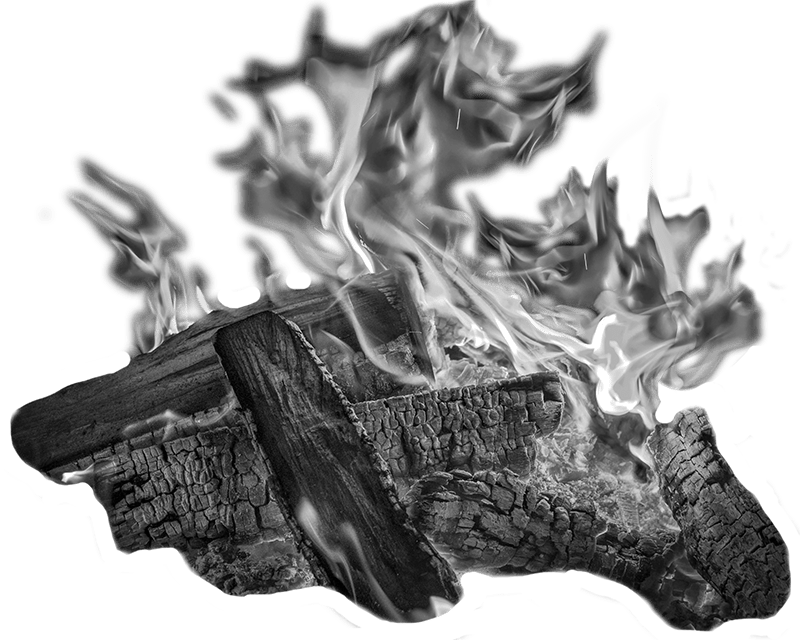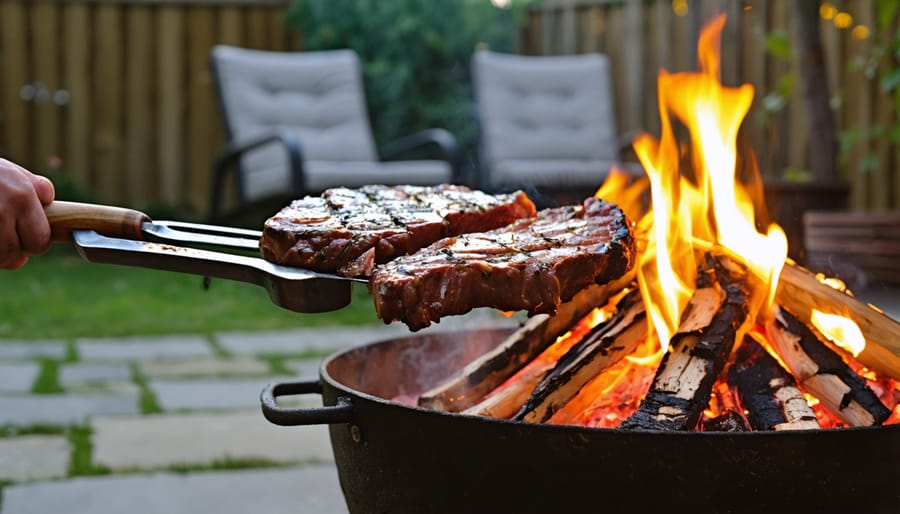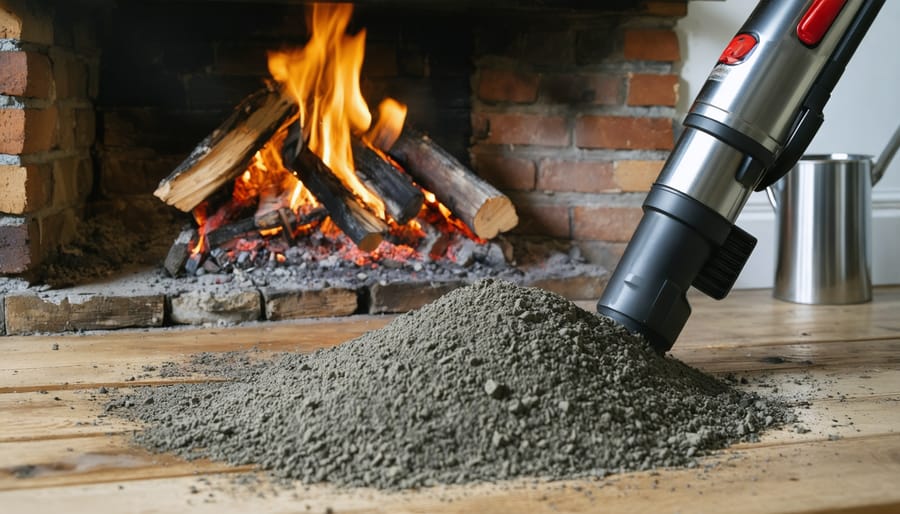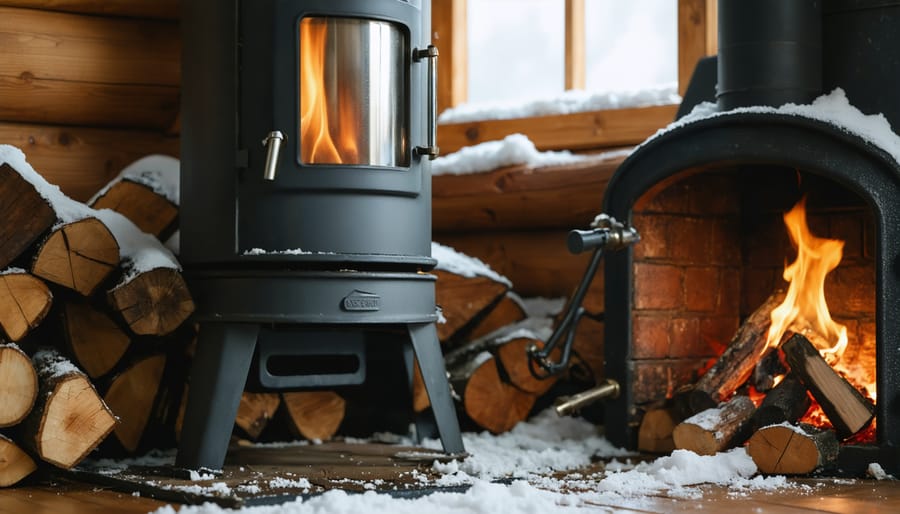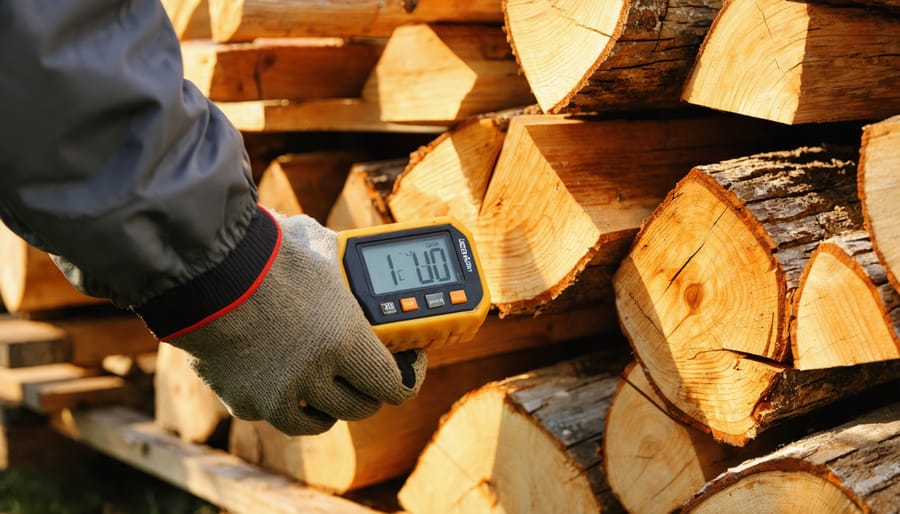Invest in long-handled tools that keep your hands at least 18 inches from flames and embers—cast iron fire pit forks, spatulas, and grill grates are essential for safely managing the best meats to cook over open flames. Choose utensils made from heavy-gauge steel or cast iron rather than standard kitchen implements, as these materials withstand direct fire contact without warping or releasing harmful chemicals into your food.
Position a sturdy tripod grill or swing-arm cooking system over your fire pit to create adjustable heat zones, allowing you to sear proteins over high heat then move them to cooler areas for finishing. This setup transforms your backyard fire feature from simple ambiance into a versatile outdoor kitchen.
Select utensils with heat-resistant wooden or wrapped handles rather than bare metal, preventing burns during extended cooking sessions. A quality fire poker, ash shovel, and heavy-duty tongs become indispensable when rearranging logs to maintain consistent cooking temperatures.
Build your collection around multi-purpose tools first—a long-handled spatula works for burgers, vegetables, and fish, while adjustable grill grates accommodate everything from cast iron skillets to direct-flame cooking. This practical approach saves money while ensuring you have functional equipment for any fire pit meal.
Prioritize tools specifically designed for live-fire cooking over modified indoor utensils, as proper fire pit implements feature appropriate length, weight distribution, and material composition for safe outdoor use. This investment protects both your safety and food quality while honoring the timeless tradition of cooking over open flames.
Why Fire Pit Cooking Utensils Matter More Than You Think
If you’ve ever tried flipping burgers over an open flame with your everyday kitchen spatula, you’ve probably learned this lesson the hard way: regular cooking tools simply weren’t designed for the challenge of fire pit cooking. The difference between standard utensils and their fire pit counterparts isn’t just marketing hype—it’s a matter of safety, functionality, and getting the most from your outdoor cooking experience.
The most obvious distinction is heat resistance. While your indoor spatula might handle a hot stovetop, fire pit cooking exposes tools to significantly higher temperatures and direct flame contact. Specialized fire pit utensils feature heat-resistant materials that won’t warp, melt, or conduct dangerous amounts of heat up the handle. This durability means your tools will last season after season, making them a worthwhile investment for anyone serious about outdoor cooking.
Handle length makes an enormous difference in your comfort and safety. Fire pit utensils typically feature handles that are several inches longer than standard kitchen tools, keeping your hands and arms at a safe distance from intense heat and occasional flare-ups. This extra reach isn’t just about avoiding burns—it gives you better control and maneuverability when working over an unpredictable flame.
Outdoor conditions demand tougher construction too. Fire pit utensils need to withstand exposure to smoke, moisture, temperature extremes, and the occasional drop onto stone or dirt. Quality outdoor cooking tools are built with sturdier materials and reinforced connections that regular kitchen utensils simply don’t require.
Beyond safety and durability, proper fire pit utensils genuinely improve your cooking results. They’re designed with features like angled heads for better flame access and gripping surfaces that secure food more effectively. When you’re creating memorable meals around the fire, having the right tools transforms the experience from frustrating improvisation into confident, enjoyable cooking that brings friends and family together.
Essential Grilling and Cooking Utensils for Your Fire Pit

Long-Handle Grilling Tools
When you’re cooking over an open fire pit, keeping a safe distance from the flames isn’t just smart—it’s essential. Long-handle grilling tools are your best friends here, giving you the reach you need to flip, turn, and serve without sintering your eyebrows. The sweet spot for handle length is typically between 16 and 20 inches, which provides ample distance from heat while maintaining good control over your food.
Material choice makes a significant difference in both performance and longevity. Stainless steel tools are the go-to for most fire pit cooks because they resist rust, clean up easily, and won’t impart metallic flavors to your food. They’re also lighter weight, making them easier to maneuver during longer cooking sessions. Cast iron tools, while less common, offer exceptional heat resistance and durability, though they do require more maintenance to prevent rust.
Your essential long-handle trio should include a sturdy spatula for burgers and fish, tongs for everything from sausages to vegetables, and a fork for larger cuts of meat. Look for tools with ergonomic grips—preferably made from heat-resistant materials like wood or silicone—that stay cool even during extended use. Spring-loaded tongs with scalloped edges provide better grip, while spatulas with beveled edges slide under food more easily.
Consider tools with hanging loops for convenient storage near your fire pit. This practical feature keeps your utensils organized and readily accessible when the flames are ready and your guests are hungry.
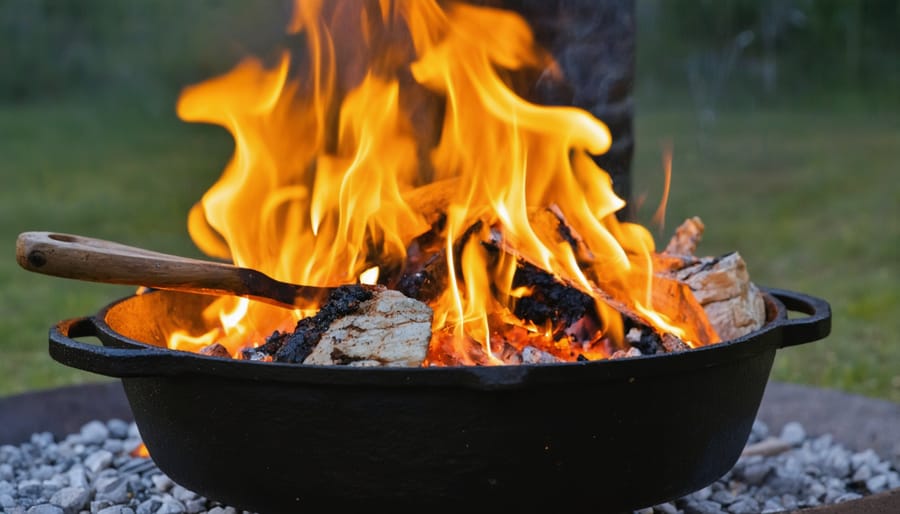
Cast Iron Cookware for Fire Pit Mastery
Cast iron cookware has been the gold standard for fire pit cooking for centuries, and with good reason. These timeless pieces transform your outdoor cooking space into a versatile culinary hub, perfect for everything from morning pancakes to evening stews.
The beauty of cast iron lies in its exceptional heat distribution. Unlike thinner metals that create hot spots, cast iron absorbs heat slowly and releases it evenly across the entire cooking surface. This makes skillets ideal for achieving perfectly seared steaks, while Dutch ovens create the consistent temperatures needed for slow-cooked chilis and campfire bread. Griddles expand your possibilities even further, letting you cook breakfast for a crowd with room for eggs, bacon, and hash browns all at once.
Before your first use, proper seasoning creates a natural non-stick surface that improves with age. Simply coat your cookware with a thin layer of vegetable oil and heat it until the oil polymerizes, creating that signature black patina. This protective layer prevents rust and makes cleanup easier after each use.
The versatility of cast iron makes it invaluable for mastering outdoor cooking. You can use these pieces directly on grates, nestle them into hot coals, or hang them from a tripod. They transition seamlessly from searing to simmering, and their durability means they’ll last generations with minimal care. After cooking, let them cool naturally, clean with hot water and a stiff brush, then apply a light oil coating to maintain that seasoned surface. This simple routine keeps your cast iron ready for countless fireside meals.
Rotisserie Systems and Skewers
Rotisserie cooking transforms your fire pit into an outdoor kitchen centerpiece, bringing restaurant-quality results to your backyard. Motorized rotisserie systems offer hands-free convenience, slowly rotating whole chickens, roasts, or vegetables for even browning and self-basting perfection. Look for electric motors with adjustable speeds and weight capacities ranging from 15 to 50 pounds, depending on what you plan to cook. Manual crank systems provide a more traditional, involved approach and don’t require electrical outlets, making them ideal for remote locations.
When selecting a rotisserie setup, ensure your fire pit has adequate support brackets or purchase a freestanding unit that positions over your fire. Most systems include sturdy stainless steel skewers with secure prongs to hold food firmly in place. Kabob skewers deserve special attention—choose flat-sided metal designs that prevent food from spinning independently, or opt for double-prong versions for stability.
Rotating basket systems offer versatility for smaller items like vegetables, fish, or delicate proteins that might fall apart on traditional skewers. These wire baskets typically feature adjustable compartments and lockable doors. For safety and longevity, verify all components are heat-resistant to at least 500 degrees Fahrenheit and include heat-safe handles for adjustments during cooking.
Pokers, Ash Rakes, and Fire Management Tools
Managing your fire pit effectively is just as important as the food you’re preparing. Think of pokers and ash rakes as your fire’s best friends—they help you create those perfect cooking zones where some areas run hot for searing while others maintain gentle heat for slow cooking.
A long-handled poker, ideally 30 inches or more, lets you safely reposition burning logs without getting too close to the flames. This distance matters not just for safety but for your comfort during extended cooking sessions. Pair it with a sturdy ash rake to clear away spent coals and create clean cooking surfaces. These tools work together to give you precise temperature control, which transforms your fire pit from a simple campfire into a legitimate outdoor kitchen.
Look for tools crafted from heavy-duty steel or wrought iron that won’t bend under the weight of hefty logs. Many quality sets include a shovel for adding or removing coals, plus a brush for cleaning grates between courses. This combination approach to fire management supports both efficient cooking and eco-friendly practices by helping you burn wood completely and minimize waste. With proper fire management tools at your side, you’ll master the art of maintaining consistent heat throughout your entire cooking experience.
Specialty Utensils That Elevate Your Fire Pit Cooking Game
Grill Grates and Adjustable Cooking Surfaces
The foundation of fire pit cooking starts with choosing the right grate for your setup. Heavy-duty cast iron grates are the workhorses here, retaining heat beautifully and creating those gorgeous sear marks on your steaks. Look for grates with closely-spaced bars to prevent smaller foods from falling through while still allowing excellent heat circulation. Stainless steel options offer a lighter alternative that resists rust, though they won’t hold heat quite as long.
Temperature control transforms good fire pit cooking into great results, and adjustable height systems give you that precision. Simple chain-and-hook setups let you raise or lower your grate to find the perfect cooking zone—high for a quick sear, lower for gentler cooking. Some systems feature notched posts that hold grates at preset heights, giving you consistent, repeatable results every time you cook.
Swing-arm grills take flexibility even further, allowing you to rotate your food completely away from the flames when needed. This design element lets you tend the fire, add wood, or simply pause the cooking process without removing hot grates. Many swing-arm models also incorporate height adjustment, giving you complete command over your cooking temperature. These versatile systems turn your fire pit into a genuine outdoor kitchen, perfect for those leisurely weekend gatherings where cooking becomes part of the entertainment itself.
Pie Irons, Baskets, and Specialty Cookers
Specialty fire pit cookers transform your backyard gathering into a culinary adventure, bringing nostalgic campfire favorites and creative new dishes to your outdoor space. Pie irons, also called pudgy pie makers or mountain pie makers, are hinged cast iron pockets that create delicious sealed sandwiches right over the flames. Simply butter your bread, add sweet or savory fillings, clamp the iron shut, and toast over the coals for perfectly golden pockets of melted goodness.
Long-handled hot dog and marshmallow forks keep hands safely away from heat while achieving that perfect char. Look for telescoping models that adjust to your fire’s intensity and feature heat-resistant grips. Corn roasting baskets cradle ears securely while allowing even charring and easy rotation—a game-changer for summer cookouts.
For adventurous cooks, vertical chicken roasters and rib racks designed for fire pit use unlock possibilities beyond burgers and hot dogs. These tools work beautifully when combined with smoking techniques, adding depth to your outdoor cooking repertoire. Cast iron options provide superior heat retention and durability, though stainless steel alternatives offer lighter weight for easier handling. These specialty tools typically require minimal maintenance—just clean thoroughly after use and keep cast iron seasoned to prevent rust and ensure decades of delicious fire pit memories.
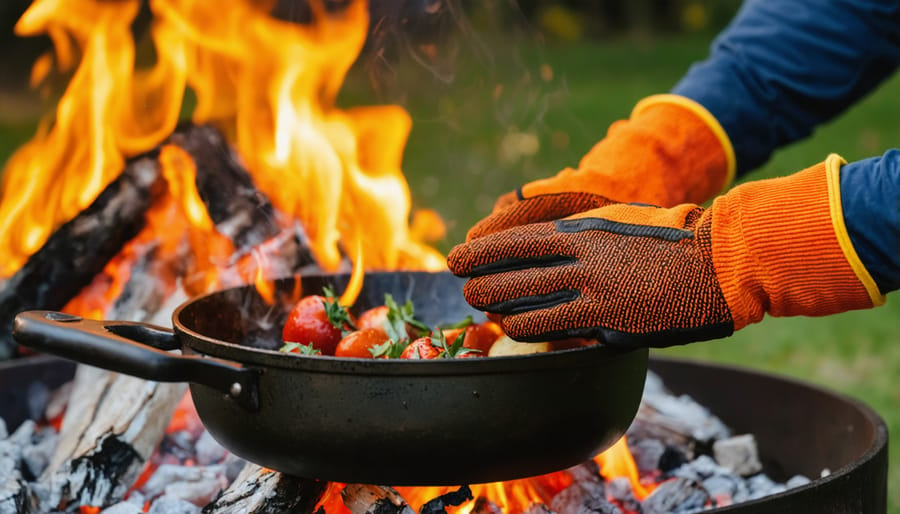
Heat-Resistant Gloves and Protective Gear
When you’re cooking over an open fire, protecting your hands isn’t just smart—it’s essential. The cookware you’ll be handling reaches temperatures that can cause serious burns in seconds, making quality heat-resistant gloves one of your most important investments.
Leather gloves offer excellent heat protection and durability, making them ideal for handling cast iron cookware and adjusting grates. They provide a secure grip and develop character over time, though they require occasional conditioning to maintain their protective qualities. Silicone gloves, on the other hand, are water-resistant and easier to clean, perfect for those messy barbecue sessions. They’re typically rated to withstand temperatures up to 500°F and won’t absorb food odors.
Beyond gloves, consider adding a heavy-duty apron to protect your clothing from sparks and splatters. Long sleeves made from natural fibers like cotton provide additional arm protection without the melt risk of synthetic materials. Keep a pair of safety glasses handy when stoking the fire, and always position yourself upwind to avoid smoke exposure. These simple protective measures transform your fireside cooking from risky business into a confident, enjoyable experience that lets you focus on creating memorable meals around the warmth of the flames.
Material Matters: Choosing Durable and Safe Fire Pit Utensils
When you’re cooking over an open fire, your utensils face far more intense heat than anything in your kitchen. Understanding what your tools are made from isn’t just about performance—it’s about safety and getting good value from your investment.
Stainless steel stands as the most popular choice for fire pit cooking tools, and for good reason. It resists rust beautifully, requires minimal maintenance, and handles high temperatures without warping. Look for 18/8 or 18/10 stainless steel grades, which indicate higher nickel content for better corrosion resistance. The downside? Quality stainless steel utensils come with a higher price tag, and cheaper versions may bend or deteriorate quickly under fire pit conditions.
Cast iron brings serious durability to the table. These tools can withstand extreme temperatures and last generations when properly cared for. They’re particularly excellent for grates, skillets, and heavy-duty implements. However, cast iron demands respect—it needs regular seasoning to prevent rust, can be quite heavy to handle, and requires patience in maintenance. Think of cast iron as the heirloom option that rewards your commitment with decades of reliable service.
Carbon steel offers a middle ground, combining strength with lighter weight than cast iron. It heats quickly and evenly, making it ideal for cooking surfaces and griddles. Like cast iron, it needs seasoning and protection from moisture, but it’s more responsive to temperature changes and easier to maneuver around the fire.
Handle materials deserve equal attention. Wood handles provide comfortable grips and natural insulation from heat, but they can char or loosen over time near flames. Many fire pit enthusiasts prefer long stainless steel handles that keep hands safely away from heat, often with heat-resistant grips on the ends. Whatever material you choose, ensure handles extend at least 12-15 inches to protect you from the fire’s intensity while creating that warm, inviting outdoor cooking experience.
Safety First: Using Fire Pit Cooking Tools Properly
Cooking over an open fire creates wonderful memories and delicious meals, but safety must always be your top priority. Quality fire pit cooking tools aren’t just about convenience—they’re essential protective equipment that stands between you and potentially serious burns.
Before each cooking session, inspect your utensils carefully. Look for signs of heat damage like warping, cracks in handles, or compromised welds. Even small damage can lead to tool failure at the worst possible moment, so replace anything that shows wear. This simple check takes just a minute but can prevent accidents.
Maintain a safe working distance from the flames using long-handled tools designed specifically for fire pit cooking. Standard kitchen utensils simply aren’t long enough, putting your hands and arms dangerously close to intense heat. Look for handles at least 15 to 20 inches long that stay cool to the touch.
When placing cookware over the fire, ensure everything sits stable and secure. Wobbly grates or unbalanced pots can spill scalding food or tip into the flames. Take time to adjust your setup before adding food, and never leave cooking unattended.
Always use heat-resistant gloves when handling hot utensils, even those with supposedly cool-touch handles. Keep a designated safe zone for placing hot tools down—never set them where someone might accidentally grab them.
Finally, establish clear boundaries keeping children and pets at least three feet away from the cooking area. The combination of open flames, hot surfaces, and long-handled tools requires constant awareness. Quality tools reduce risks, but vigilant supervision completes your safety strategy for enjoyable fireside cooking.
Caring for Your Fire Pit Cooking Utensils
Proper care of your fire pit cooking utensils ensures they’ll serve you well for countless gatherings around the fire. After each use, let your tools cool completely before cleaning. For most utensils, a simple wash with warm water and biodegradable dish soap works perfectly. Skip harsh chemical cleaners that can leave residues and harm the environment around your outdoor living space.
Cast iron pieces require special attention. After cleaning, dry them thoroughly and apply a light coat of cooking oil to prevent rust. If you’re new to seasoning cast iron, remember this simple maintenance step preserves your tools and improves their performance over time.
For stubborn ash and smoke buildup, create a natural cleaning paste using baking soda and water. This eco-friendly solution cuts through residue without toxic chemicals. Stainless steel tools benefit from occasional vinegar rinses to restore their shine.
Storage matters just as much as cleaning. Keep your utensils in a dry location, whether that’s a covered outdoor storage box or inside your home. Moisture is the enemy of metal tools, leading to rust and deterioration. Consider hanging tools on hooks to promote air circulation.
Inspect your utensils regularly for signs of wear. Wooden handles that crack or splinter, bent metal parts, or rust that won’t budge signal it’s time for replacement. Quality tools last years with proper care, but safety always comes first. Well-maintained fire pit utensils become trusted companions in creating memorable outdoor cooking experiences.
Building Your Fire Pit Cooking Toolkit on Any Budget
Getting started with fire pit cooking doesn’t require breaking the bank, but knowing where to invest your dollars makes all the difference between frustration and delicious outdoor meals.
For beginners just dipping their toes into fire pit cooking, start with these three essentials: a quality pair of long-handled tongs (at least 16 inches), heavy-duty heat-resistant gloves, and a simple grill grate that fits your fire pit dimensions. This starter trio typically runs under $75 and handles about 80% of basic cooking tasks. Add a cast iron skillet as your fourth purchase—it’s versatile, affordable, and becomes a workhorse for everything from eggs to cornbread. These foundational tools let you experiment and discover your cooking style before committing to specialized equipment.
As your confidence grows and fire pit cooking becomes a regular lifestyle element around your home, expand strategically. Prioritize items based on what you cook most often. Love grilled meats? Invest in a quality rotisserie setup. Prefer one-pot meals? Consider a tripod with adjustable chains and a Dutch oven. Pizza enthusiasts should save for a proper pizza peel and stone.
For serious outdoor chefs ready to build a comprehensive toolkit, budget $300-500 for a full setup including multiple cooking surfaces, specialized tools like pie irons and roasting forks, and proper storage solutions. Remember that quality often trumps quantity—one excellent chef’s knife beats five mediocre ones.
The eco-friendly approach means choosing durable, repairable tools over disposable options. Cast iron and stainless steel last decades with proper care, making them better environmental and financial investments. Start small, buy quality when possible, and let your collection grow naturally with your skills and enthusiasm.
The right fire pit cooking utensils truly transform your outdoor cooking experience from ordinary to extraordinary. While it might seem like just another investment, quality tools make the difference between struggling with burned fingers and scorched food versus creating restaurant-quality meals under the stars. The beauty of building your fire pit kitchen is that you don’t need everything at once. Start with the essentials—a sturdy pair of long-handled tongs, a reliable grill grate, and heat-resistant gloves—then expand your collection based on your cooking style and the dishes you love most.
As you grow more comfortable with open-flame cooking, you’ll discover which specialty tools enhance your experience. Perhaps you’ll add a Dutch oven for slow-cooked stews, or maybe rotisserie attachments will become your favorite way to prepare weekend feasts. Each tool you choose becomes part of creating those memorable moments gathered around the fire with family and friends.
Fire pit cooking represents more than just an alternative cooking method—it’s about embracing sustainable outdoor living and reconnecting with time-honored traditions. With the right utensils at your side, every meal becomes an opportunity to slow down, savor the experience, and create lasting memories in the warmth of the fire’s glow.
